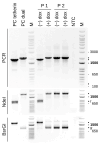Expression of an Efficient Selection Marker Out of a Duplicated Site in the ITRs of a Modified Vaccinia Virus Ankara (MVA)
- PMID: 39772039
- PMCID: PMC11680203
- DOI: 10.3390/vaccines12121377
Expression of an Efficient Selection Marker Out of a Duplicated Site in the ITRs of a Modified Vaccinia Virus Ankara (MVA)
Abstract
Background/Objectives: Poxviruses are large DNA viruses that replicate in the host cytoplasm without a nuclear phase. As vaccine vectors, they can package and express large recombinant cassettes from different positions of their genomic core region. We present a comparison between wildtype modified vaccinia Ankara (MVA) and isolate CR19, which has significantly expanded inverted terminal repeats (ITRs). With this expansion, a site in wildtype MVA, called deletion site (DS) IV, has been duplicated at both ends of the genome and now occupies an almost central position in the newly formed ITRs. Methods: We inserted various reporter genes into this site and found that the ITRs can be used for transgene expression. However, ITRs are genomic structures that can rapidly adapt to selective pressure through transient duplication and contraction. To test the potential utility of insertions into viral telomers, we inserted a factor from the cellular innate immune system that interferes with viral replication as an example of a difficult transgene. Results: A site almost in the centre of the ITRs can be used for transgene expression, and both sides are mirrored into identical copies. The example of a challenging transgene, tetherin, proved to be surprisingly efficient in selecting candidate vectors against the large background of parental viruses. Conclusions: Insertion of transgenes into ITRs automatically doubles the gene doses. The functionalisation of viruses with tetherin may accelerate the identification and generation of recombinant vectors for personalised medicine and pandemic preparedness.
Keywords: MVA; innate immune system; inverted terminal repeat; tetherin; vaccinia.
Conflict of interest statement
S.A., N.S., A.K., V.S., and I.J. are inventors of patents that are based on the data described in this publication (patent numbers not available at the time of submission of the manuscript). All Authors were employed by the company ProBioGen AG.
Figures









Similar articles
-
A Deleted Deletion Site in a New Vector Strain and Exceptional Genomic Stability of Plaque-Purified Modified Vaccinia Ankara (MVA).Virol Sin. 2020 Apr;35(2):212-226. doi: 10.1007/s12250-019-00176-3. Epub 2019 Dec 12. Virol Sin. 2020. PMID: 31833037 Free PMC article.
-
Expanding the repertoire of Modified Vaccinia Ankara-based vaccine vectors via genetic complementation strategies.PLoS One. 2009;4(5):e5445. doi: 10.1371/journal.pone.0005445. Epub 2009 May 6. PLoS One. 2009. PMID: 19421328 Free PMC article.
-
Transgene expression knock-down in recombinant Modified Vaccinia virus Ankara vectors improves genetic stability and sustained transgene maintenance across multiple passages.Front Immunol. 2024 Feb 6;15:1338492. doi: 10.3389/fimmu.2024.1338492. eCollection 2024. Front Immunol. 2024. PMID: 38380318 Free PMC article.
-
[Modified vaccinia virus ankara (MVA)--development as recombinant vaccine and prospects for use in veterinary medicine].Berl Munch Tierarztl Wochenschr. 2015 Nov-Dec;128(11-12):464-72. Berl Munch Tierarztl Wochenschr. 2015. PMID: 26697713 Review. German.
-
Vaccinia vectors as candidate vaccines: the development of modified vaccinia virus Ankara for antigen delivery.Curr Drug Targets Infect Disord. 2003 Sep;3(3):263-71. doi: 10.2174/1568005033481123. Curr Drug Targets Infect Disord. 2003. PMID: 14529359 Review.
References
-
- Mayr A., Hochstein-Mintzel V., Stickl H. Abstammung, Eigenschaften Und Verwendung Des Attenuierten Vaccinia-Stammes MVA. Infection. 1975;3:6–14. doi: 10.1007/BF01641272. - DOI
-
- Meisinger-Henschel C., Schmidt M., Lukassen S., Linke B., Krause L., Konietzny S., Goesmann A., Howley P., Chaplin P., Suter M., et al. Genomic Sequence of Chorioallantois Vaccinia Virus Ankara, the Ancestor of Modified Vaccinia Virus Ankara. J. Gen. Virol. 2007;88:3249–3259. doi: 10.1099/vir.0.83156-0. - DOI - PubMed
LinkOut - more resources
Full Text Sources
Research Materials

